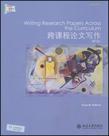跨课程论文写作
2008-9
北京大学出版社
胡布赫
450
无
北京大学出版社2008年最新引进了一套国外畅销的《英语写作原版影印系列丛书》,并邀请我为这套丛书写序,谈谈我对英语写作教学与研究的一些认识。我仔细翻阅后,觉得这套书特色十分鲜明,其中有几本再版达十次以上,经久不衰,非常乐意在此推荐给我国的广大读者。 在经济全球化和网络高度发达的今天,学好英语已变得十分重要,英语口头与书面语的表达能力已逐渐成为当今的核心竞争力之一,从第二语言学习的社会文化观看,能否流利地运用外语进行口头或书面交流已直接关系到学生的就业和未来发展。中国的英语写作教学有许多问题需要深入探讨,引进国外优秀的英语写作教学与研究成果,对于更新我国的英语写作教学观念和方法,改革当前的英语写作教学具有重要意义。 一、国内外二语写作研究概览 第二语言写作的教学与研究在国际上一直受到重视,国外的写作教学研究十分活跃,以美国为例,美国普度(PURDUE)大学每年定期召开二语写作学术研讨会,2008年6月6——7日召开的第7届写作年会的主题是:外语写作教学:原理与实践。二语写作拥有自己的研究队伍、研究机构、学术期刊。概括起来,国际二语写作研究集中在四个领域。
全书共由8个部分组成,外加5个附录和4个学生论文范例。具体介绍如下: (1)第一部分介绍“论文”的概念、内涵及如何做论文。在开始介绍前,作者还提供了本书使用的指南,提示读者如何使用本书。 (2)第二部分具体介绍开始论文写作的方法与步骤:论文写作该从哪里具体入手?作者具体介绍了论文写作的“五步法”:第一步做好笔记;第二步确定选题;第三步形成论文写作的初步问题和框架;第四步进一步确定中心论题;第五步选择研究战略(研究的具体问题)。在此基础上,最后形成论文的雏形。作者还进一步建议论文写作应事先确定一份时间表以利于论文的完成。 (3)第三部分在第二部分介绍论文确定论点的基础上,具体介绍如何找到论据来为之前确定的论点服务。作者具体介绍了研究者的立场、论据的来源及如何下载和保存使用网络资源等方法。 (4)第四部分在第三部分寻找论据和资源的基础上进一步指导读者如何合理和正确使用找到的各类资源:即要求读者要学会批判性阅读并及时记笔记。 (5)第五部分介绍论文写作的具体过程:包括论文的受众、论文写作由整体到局部写作,以及反复审视你所使用的论据。该部分还具体介绍了几种论文的写作格式,比如学习或实验报告的写作、综述或文学论文的综述写法、批判性论文的写作、论文的草稿及修改,以及其他有关论文写作格式的问题。 (6)第六部分聚焦论据在论文中的使用问题,主要介绍如何正确引用他人的论点,避免引用他人内容的过程中出现抄袭嫌疑和问题的方法。 (7)第七、八部分重点介绍论文写作的收尾工作:第七部分作者介绍终稿前作者应做的几件事情,包括仔细检查文本和校读终稿,并从总体上润色和把握文章的格式;第八部分重点介绍英文参考文献的引用方式和方法,具体介绍部分英文文献的引用格式,并推荐读者如何在合适的时间从事参考文献的编辑工作。 (8)附录A-D依次具体介绍现行的英文论文写作的4种格式:即MLA格式、CMS格式、APA格式,以及科技文献格式CMS作者—日期格式以及CSE格式的两种体系,为读者提供最全最新入时的英语论文的具体写作格式。附录E则重点介绍论文写作中可能涉及到的面试/面谈的问题,包括如何设计和从事必要的面谈/面试问题及如何写作相应的工作报告。为更具体地向读者展示本书的指导性意义,作者最后还为读者提供了4篇学生论文写作范例,每一篇分别使用了上述提到的四种不同格式中的一种,为读者提供有益的参考。
Susan M.Hubbuch现为美国波特兰的Lewis &Clark学院写作中心主任,常年从事指导本科与研究生的论文写作工作,具有丰富的论文写作指导经验。
SECTION 1 What Is a Research Paper? A.HowtoUseThisGuide B.Overvicw:What Is a Research Paper? C.Leaming,Thinking,and Research Papers 1.hc evidence a.Fads b.0nkfences c.Judgments 2.Evaluating the evidence 3.Sources of evidence and types of research projects D.SummarySECTION 2 Where Do I Begin? A.Step 1:The Researcher's Notebook B.Step2:Deciding on the Research Question/Assumption That You Are Cioing to Tesf C.Step 3:Formula.ng Your Research Question/Assumption D.Step 4:Formulating Your Working Hypothesis/7hesis 1.Strategy 1:Discovering your assumpfions about your area of investigation 2.Strategy2:durning judgmental statements into inferences 3.Strategy3:Deftning your terms E.Step 5:Choosing Your Research$Wategy-Research Questions F. A Few More Words about Research Projects and Testing 1. Studies and experiments 2. A review or a review of the literature paper 5. Critica.papers G.A Research Proposal H.AFinalNote L Planning Ahead:Devdoping a Work ScheduleSECTION 3 Finding the Evidence A. The Researcher's Stanee B.Sources and Resources 1.soures:Where do I find what I need to know! 2. Authoritative sources 3.Resources C.The Research Process 1.What to expect and how to manage 2.Bibliographic.filing"systems 3.Searching for potential soUrces a.Know your database b.Searches by subject and keyword C.What.your search will produce 4.Locating print soUrceS D.Evaluating Online Sources E.Information to Record about Electronic Sources F.SunnarySECTION 4 Reading Critically and Talking Notes A. Reading Actively and Critically:An Overview B. Previewing Your Sources 1.Determining the quality of your sources 2.Deciding what to read first 3.Coping with Read first C.Reading to Understand what an Author is Doing and Saying 1.Questions to ask about what an author is Doing 2.Questions to ask about what an author is Saying 3.Wrinting to comprehend what you are reading 4.Critiquing your sources D. Keeping Track of the Evidence:An Overview E.Creating Files and a Cataloging System F.Creating a Working Bibiliography G.Writing Summaries(with a Few Words about Annotated Bibliographies) H.Recording Specific Pieces of Information 1.Facts or data 2.Specifics about the author's views 3.Dealing with material an author has taken from other sources I.SummarySECTION 5 Writing Your PaperSECTION 6 How to and How Not to Incorporate Your Evidence into Your PapterSECTION 7 Polishing Your Final DraftSECTION 8 Documenting Your Sources:The BasicsAPPENDIX A The MLA StyleAPPENDIX B The CMS Notes & Bibliography StyleAPPENDIX C The APA StyleAPPENDIX D Scientific Style:The CMS Author-Date Style and Two Systems in the CSE StyleAPPENDIX E InterviewsSample Student Papers
To many students, there is nothing more discouraging-or even frightening than the words“you are required to do a research paper for this course。”“Research paper”often conjures up a depressing picture of hours of frustration and mindless busywork.Not knowing where to begin or what to do,many students spend weeks fretting-and proctrastinating.Finally,a few weeks-or perhaps a few days-before the paper is due,they force themselves to do a few from the library.Back at their desks,surrounded by an imposing pile of“stuff,”they struggle to find a way to string all this information into some sort of paper that“flows.”
为更具体地向读者展示《跨课程论文写作(第5版)》的指导性意义,《跨课程论文写作(第5版)》作者最后还为读者提供了4篇学生论文写作范例,每一篇分别使用了上述提到的四种不同格式中的一种,为读者提供有益的参考。

无
书很好,真的很实用,是全英文的哦!!!!
艺术学院的同学推荐的,看着感觉不错
质量不咋地,有的页还是空白的。